Preserved Lemons
This post may contain affiliate links. See my disclosure policy.
Get ready to unlock one of the grand secrets of Moroccan and Middle Eastern cuisine by learning how to make preserved lemons in this step-by-step tutorial. These homemade preserved lemons are a powerhouse ingredient that will infuse your dishes with such an incredible flavor and absolutely transform any dish you add them to, whether savory or sweet. Just a few minutes of your time will give you this magical ingredient that keeps for months and you can enjoy all the year through!

If you’re a fan of Moroccan and Middle Eastern cooking you’ve probably had the experience of thumbing through recipes, drooling all the while, earmarking the ones you particularly like, only to then scan through the ingredients and see the words: “Preserved Lemons”. Your heart sinks for a moment as you realize you are sorely lacking this crucial ingredient. And so with disappointment you un-earmark that page and move on to the next recipe. DON’T let that scenario stop you again. Because nothing could be easier than making your own DIY preserved lemons! These are one of my most favorite “secret” ingredients and I’m going to show you exactly how to make them and how to use them in lots of delicious ways!
What Are Preserved Lemons?
Preserved lemons are lemons that have been packed in salt and their own juices and are left to cure for about a month. During that time the flavors transform in which the acidic tartness disappears and you’re left with a very amplified and complex lemon flavor. Think of preserved lemons as lemons on steroids. They add an intense, concentrated lemon flavor to the dish without all the sour tartness. The preserving process tempers the tartness while accentuating the lemon flavor. In other words, mildly tart but intensely lemony. And if you’re a lover of all things lemon, preserved lemons need a permanent place in your pantry. I can assure you, there is virtually always a jar of these in my fridge!
This preservation process also extends the shelf life of the lemons and they’ll keep for around 6 months in your fridge and even longer if you can them. Over time the lemons become soft and to use them you simply remove however much you need, scrape off the fleshy interior, rinse off the peel, dice it up, and add it to your dishes. Preserved lemons have been around for centuries and are used extensively in Middle Eastern and North African cuisines, most famously Moroccan food. Their unique flavor adds an incredible amount of flavor to a wide variety of savory dishes and desserts.
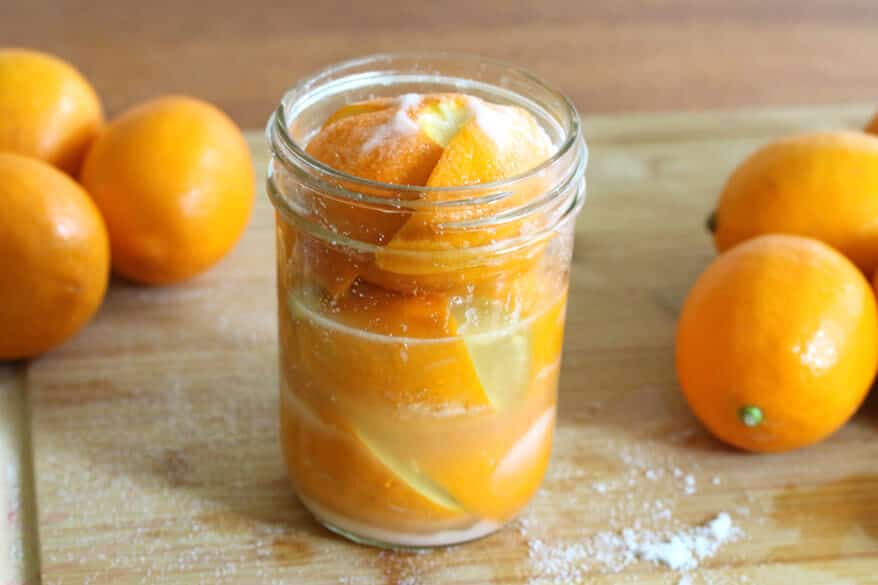
How to Use Preserved Lemons
You’ll find preserved lemons called for in a lot of Middle Eastern and Moroccan recipes, everything from tagines to stews and salads and add a uniquely tangy, salty, and mildly sweet flavor. They can be added to any dish that calls for or can benefit from a touch of lemon flavor. And that includes desserts. Here are just a few ways to use preserved lemons:
- Tagines and stews: a little goes a long way to adding life and flavor. Try them in my Moroccan Harira and Moroccan Chicken Tagine. They’re also great in a variety of bean stews and lentil soups.
- Chicken, duck, beef, lamb, pork, and fish: preserved lemons pair beautifully with any protein. Try them in my Moroccan Chicken (Djej Makalli). And of course lemon and seafood are soulmates. Now just wait until you’ve paired it with preserved lemons and your life is forever changed.
- Salads: Finely mince and toss them into your salads, including pasta salads. They also pair beautifully with grain salads and grain bowls. Try them in two of my personal favorites, this Moroccan Chicken Salad and Curried Couscous Salad.
- Rice, grain, and pasta dishes: try them in my Salmon Risotto – it’s a match made in heaven.
- Marinades: Incorporate them into marinades for chicken, lamb, pork and fish. They add just touch of acidity and a whole depth of flavor.
- Dressings, sauces and dips : Blend them into dressings, vinaigrettes and sauces for an exciting flavor punch. They also work really well in creamy sauces. Add some to your Hummus or Baba Ganoush or to some Greek yogurt along with fresh dill for a refreshing dip.
- Sandwiches and Wraps: you can even add them to your burgers for a fun flavor boost. Oh, and add them to Falafel!
- Salsas and Relishes: chop some up and it to your salsas and relishes for a unique lemony twist like my Mango Salsa and Pineapple Salsa.
- Roasted Vegetables: Toss your roasted veggies with some butter and finely minced preserved lemons for a fabulous flavor. They pair particularly well with root vegetables and cauliflower.
- Cakes, Cupcakes, Muffins, etc: Anything that you would add lemon zest to, try adding some finely minced preserved lemon. Try it in our Preserved Lemon and Ginger Pound Cake.
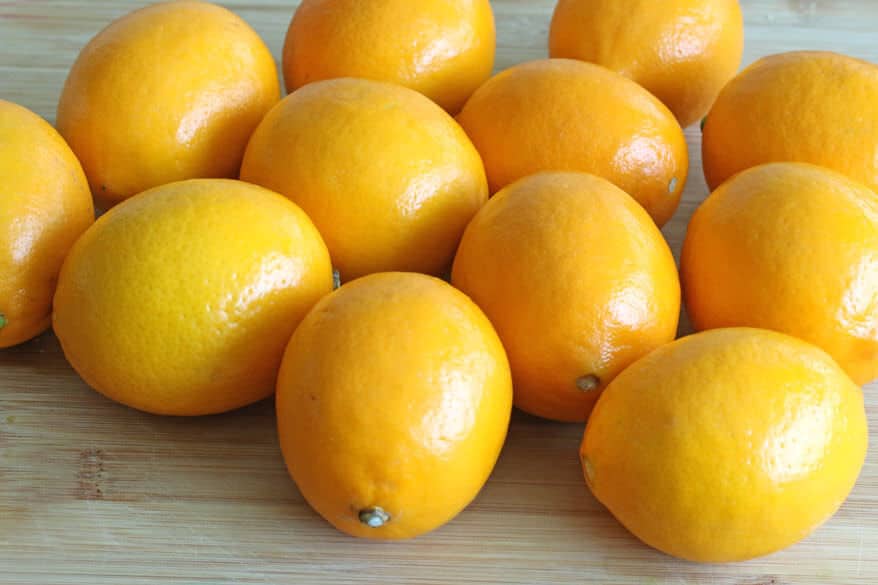
What Kind of Lemons Are Best?
Doqq and boussera lemons are commonly used in Morocco. They have thinner skins and are sweeter than regular lemons. A great substitute is Meyer lemons. If you can’t find Meyer lemons you can use regular lemons such as Eureka or Lisbon. Organic is ideal since it’s the lemon rinds that are eaten.
Variations
Did you know, you can also make preserved limes, oranges, grapefruit and kumquats! The process is identical but because high acidity is required for proper preservation and other citrus varieties have a lower acid content, you will still need to top off the jars with lemon juice. Experiment with these other citrus varieties for some fun flavor variations.
How Long Do Preserved Lemons Last?
Preserved lemons can be stored at room temperature but they’ll ferment very quickly that way and won’t keep as long. It’s recommended to store them in the fridge, in a glass jar with a lid, where they will keep for up to 6 months, and quite possibly longer. Just check periodically for any signs of mold or off colors and smells.
Preserved Lemons Recipe
Let’s get started!
Organic is ideal if you can find them since it’s the rinds that are eaten. If you can’t find organic, let the lemons soak in a vinegar-water solution for a few minutes to clean the outer peels, then rinse.
Trim the nubs off both ends of each lemon.
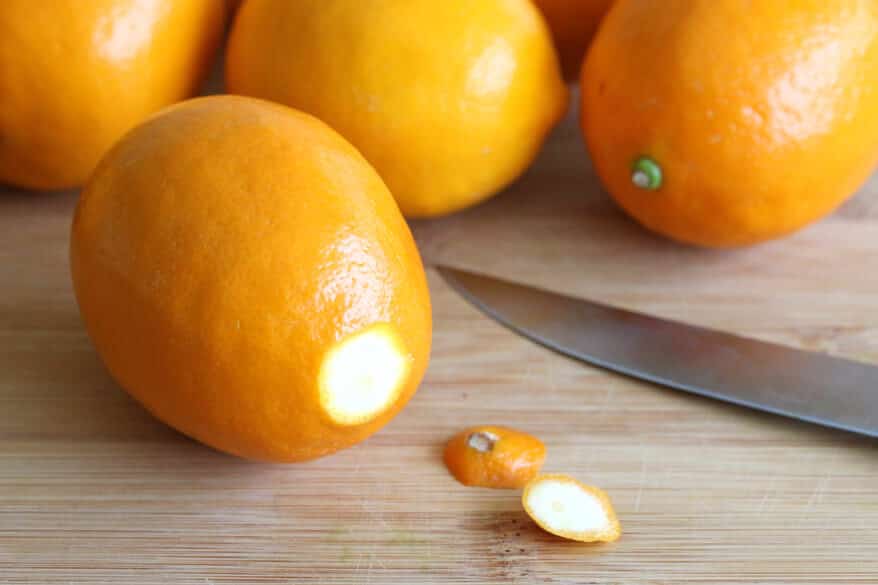
Slice the lemons into quarters, leaving the ends attached. So slice down just a little over 3/4 of the way.
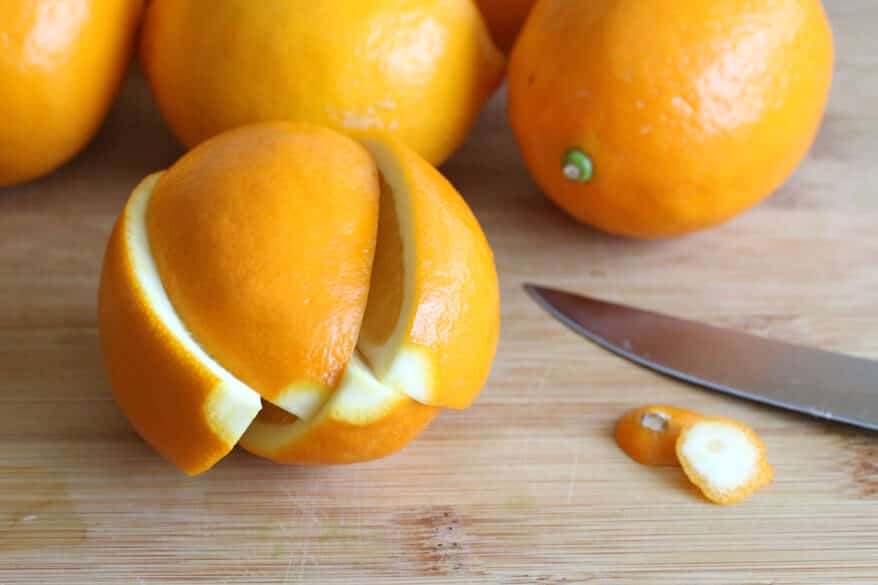
Put a teaspoon of salt in the bottom of a pint-sized jar. Put another teaspoon of salt into the quartered lemon.
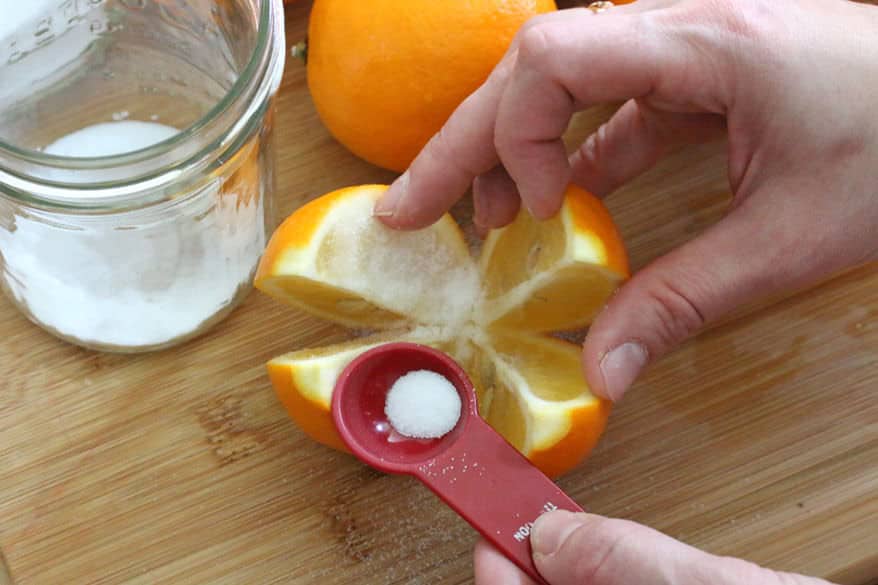
Stuff the lemon into the jar, open end down, and push hard to squish it and release its juices.
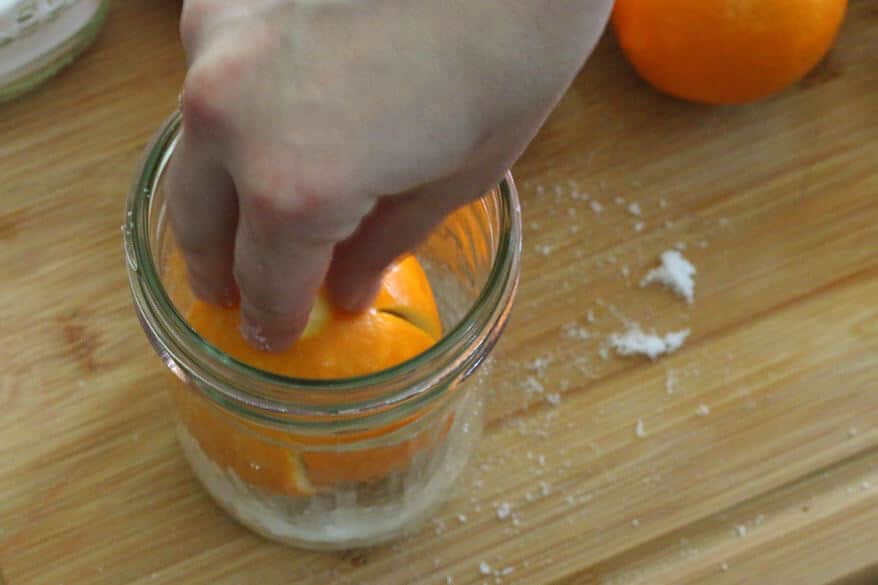
Put a teaspoon of salt over the top of the lemon.
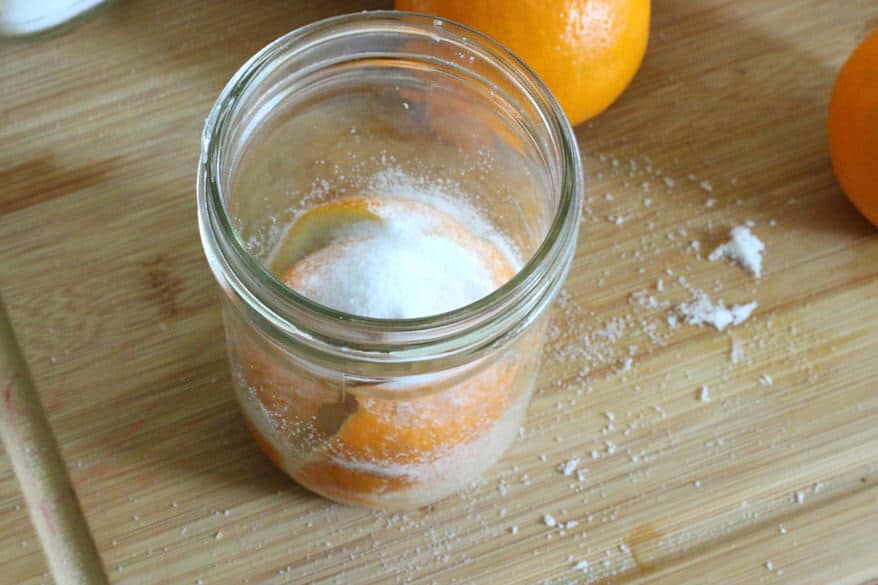
Repeat the process, putting a teaspoon of salt inside the second lemon, and then squish it down hard on top of the first lemon.
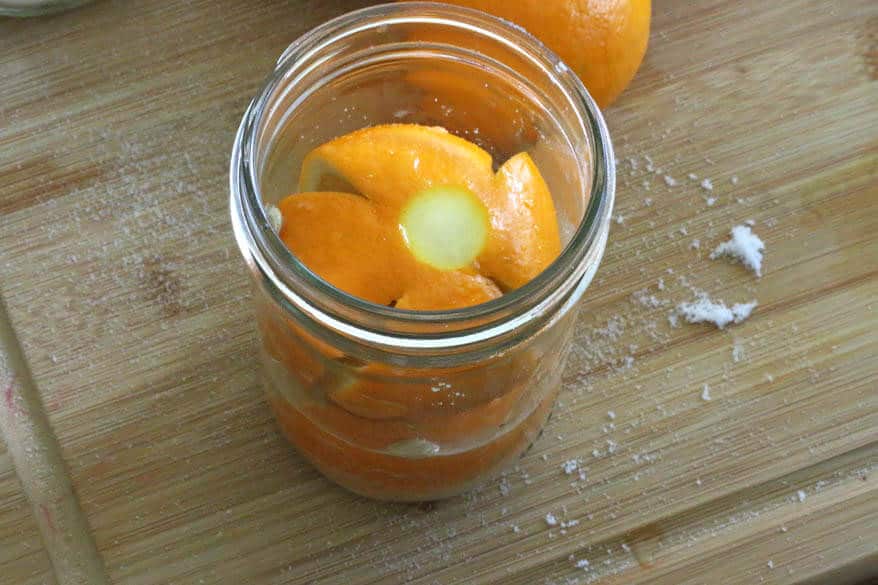
You got it – add another teaspoon of salt on top of the second lemon, and repeat the process for the third and final lemon. Add a teaspoon of salt on the very top. The jar should be at least halfway full of lemon juice from having compressed the lemons. If needed, squeeze some extra lemon juice into the jar to bring it to the halfway point. And don’t waste that lemon – cut it up and stuff it into the jar. Now pour some water that’s been boiled and cooled (sterile) into the jar to fill it up the rest of the way. Repeat this process for however many jars you wish to make.
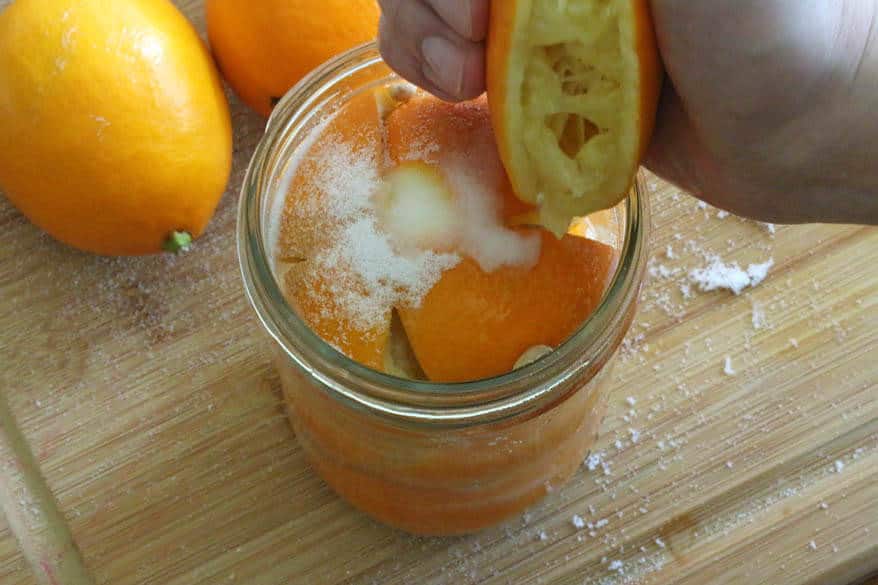
After you add the water, screw on the lid and let the jar sit at room temperature for 3 days, giving it a shake and turn it upside-down/right-side up a few times a day. After 3 days place the jar in the refrigerator and let it sit for at least 3 weeks before using. Keep the jar in the refrigerator. Whatever dish you use them in, discard the pulp (it’s the peel that is used) and thoroughly wash the peel to remove excess salt.
That’s it! Your preserved lemons are ready! *Taste bud choir breaks out into a stirring rendition of the “Hallelujah Chorus”*
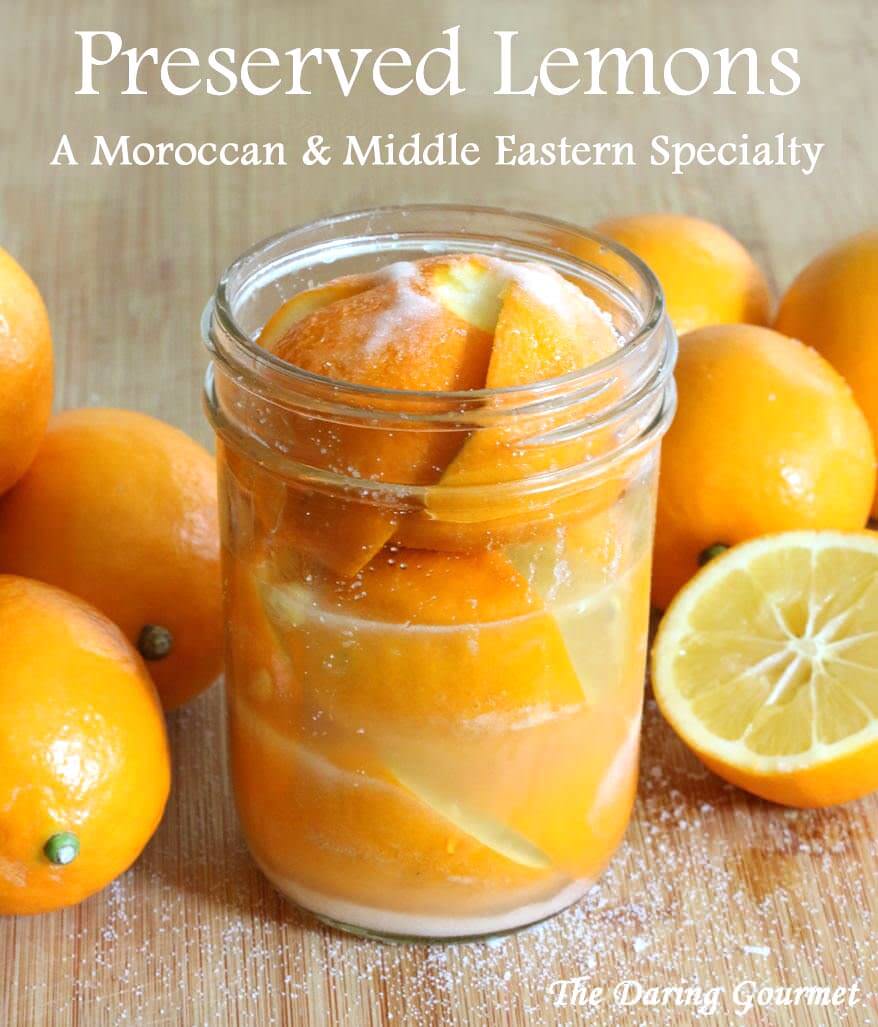
Save This Recipe

Preserved Lemons
Ingredients
- 3 Meyer lemons , or Eureka, Lisbon, etc, organic recommended per pint-sized jar
- 5-6 teaspoons sea salt or kosher salt (regular table salt contains iodine which will turn the lemons gray)
- An extra lemon for juicing
- Water that has been boiled and cooled sterile
Instructions
- Note: you can make however many preserved lemons you like, but roughly 3 will fit per pint-sized jar.Thoroughly clean the lemons. Organic is recommended. If you can't find organic, let the lemons sit in some vinegar water for a few minutes, then rinse.Trim the nubs off both ends of each lemon. Quarter each lemon, slicing them down just over 3/4 of the way to leave the slices attached at the end.Put one teaspoon of salt into the cavity of each lemon.Place one teaspoon salt into the bottom of the jar. Put a lemon in the jar, cut-side down, pressing firmly to squish out the lemon juice. Put a teaspoon of salt on top of the lemon. Firmly press the second lemon down on top of the first lemon. Repeat with the third lemon, pressing down firmly. Add a teaspoon of salt on top of the lemon.The jar should be at least halfway full with lemon juice. If needed, squeeze some additional lemon juice into the jar to bring it to the halfway point. Don't waste that lemon; slice it and stuff the slices into the jar. Pour the boiled/cooled water into the jar to fill it to the top.Screw the lid on and let it sit at room temperature for 3 days, shaking it and rotating the jar upside-down/right-side up a few times per day. After 3 days transfer the jars to the refrigerator and let them sit for at least 3 weeks before using. Stored in the fridge, they will keep for at least 6 months (see note).
Notes
* Whatever dish you use them in, discard the pulp (it’s the peel that is used) and thoroughly wash the peel to remove excess salt. * Using other citrus: You can also make preserved limes, oranges, grapefruit and kumquats! The process is identical but because high acidity is required for proper preservation you will still need to top off the jars with lemon juice.
Nutrition
Originally published on The Daring Gourmet April 8, 2014



















The lemons used in Morocco are similar to Meyer lemons, but they are not the same species.
Yes, they use doqq and boussera lemons and Meyer lemons are the most similar.
Hi Kimberly,
I just finished my very first batch of preserved lemons and can hardly wait for the next 3 days and 3 weeks to pass. I plan to ship my son a jar since he supplied the limons (not lemons) from his own tree. Must they be refrigerated during the shipping process. I live in Jersey and he in California?
Hi Diane! No, they actually don’t have to be refrigerated at all. It’s just recommended as a precaution. Your son can always refrigerate them upon arrival. Enjoy!
Making a dish tonight but can’t find preserved lemons in supermarkets or Indian store nearby. Any suggestions for you to substitute and still capture some of the flavor? Thank you. Paul
Hi Paul, that’s just the problem, there really is no substitute. The process of preserving the lemons really alters the flavor and using regular lemon in it’s place just isn’t remotely the same. I’ve seen people just some fresh lemon juice in a pinch, but again, it won’t taste anything like it’s supposed to. Buy a few lemons and get started on these preserved lemons today and you’ll have them on hand for many months whenever you need them!
Thanks for this post. I like the photos that went along with it so I knew I was doing it right, and mine look just the same. It did take longer than your stated 10 minutes, but I did 12 jars which was about 40 lemons. I have in the past just gave away all my lemons from my trees since I didn’t have anything to do with them; I hope that will change after I sample my work with one of your recipes.
Hi John, I’m happy you’ve found a new use for your lemons! These will make such wonderful gifts for your friends – it isn’t every day that people receive a classy gift like preserved lemons! – and you’ll still have plenty left over for yourself. Please let us know what you think once you’ve had the chance to try them out in one of my recipes. There are several great ones here, but I highly recommend the Djej Makalli (you can omit the olives if you’re not a fan) and the Moroccan Tagine. Happy preserving!
Thanks for the post. I’m making these again, but like others, I had no idea what to do with them when done. I had seen recipes that called for them but couldn’t remember where I saw it. Just the fact that you explained that the skin was all you used plus some of the juice makes it a no brainer now
.
Wonderful, Paul! I love these lemons and yes, they really are incredibly versatile. I included several suggestions in my post for how to use them, but there are so many additional ways. Happy preserving!
Great and easy procedure. I just made it! BTW, what can you do with the juice? Seems a waste to throw that lovely juice away.
Thanks, Bubbles. I’ll often add a bit of the juice to whatever recipe I’m using the lemons in for an added boost of flavor, like a teaspoon or two. So no, don’t go throwing it away! :)
I’ve just completed the three days/three week process but now I don’t know how to actually use the Lemon Preserve properly. For example, I have a fantastic recipe for shrimp and grits that uses lemon preserves. Do I use the juice in the jar, chop the actual lemons…? Sorry for the extremely *silly* question!
Not silly at all, Michelle! You only use the rind – so remove the interior part entirely – and be sure to thoroughly wash it to remove as much salt as possible. Depending on the recipe I’ll often add a teaspoon or so of the juice in the jar as well. Happy cooking!
So glad that I read through your reader’s posts on refrigeration. My first batch of preserved lemons have been sitting on the counter for a month, and THEN I saw the suggestion to refrigerate after 3 days! I thought “Oh no, I’ll have to throw these out even though they look and taste fine!”. Thanks so much for sharing that they can be stored without refrigeration!
Hi Lemonlover, the recipe recommends to keep them stored in the fridge per USDA guidelines, but most countries simply keep them stored in a cool, dark place and that’s what they’ve been doing for centuries. Enjoy your lemons!
Awesome recipe. Made these a few days ago and about to put them in the fridge for the three week resting period. Thanks for the easy to use recipe!
You’re welcome and thanks for the feedback!